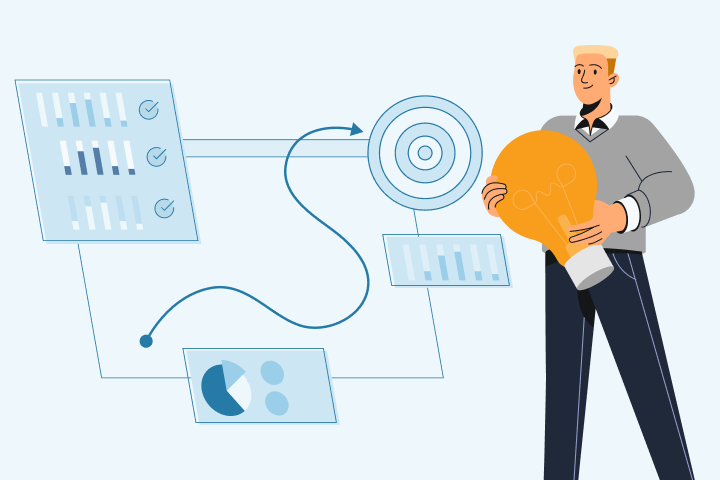Introduction To Advanced Brand Awareness Marketing Strategy
Advanced brand awareness marketing strategy is more than just a marketing buzzword. It's a tactic that mid-market and enterprise B2B tech companies use to improve their brand awareness, extending their brands’ reach and recognition.
Having an advanced brand awareness marketing strategy will not only help your brand stand out in a crowded market, but it can potentially make your brand identity synonymous with a product.
In this post, we'll dive into why brand awareness matters and how to build a strong brand presence. But, we won’t stop at just the basics. We’ll also unlock advanced strategies that go beyond the usual tips and tricks. Prepare to elevate your brand to a whole new level of brand awareness.
Ready? Let's jump in.
What Is Brand Awareness?
When you saw this image, did three specific brand names come to mind? Apple. Google. Amazon. When you see them you recognize their logos, and when you hear them, you know what they do and what they sell. That is brand awareness in a nutshell.
Brand awareness builds trust and familiarity, laying the foundation for lasting customer relationships and word-of-mouth referrals.
What Is the Difference Between Brand Awareness and Brand Recognition?
Although these two concepts go hand-in-hand, there is a difference. Brand awareness is familiarity with a brand’s image, logo, and products. Brand recognition is a step beyond brand awareness —- when the brand identity and the product sold become synonymous.
Imagine walking into a store and recognizing a logo on a product, that’s brand awareness. Now imagine asking, “Can I have a Kleenex” or “Did you Google that?” These are just two examples of brand recognition.
So, how does brand awareness fit into your social media marketing strategy?
Integrating it into your social media marketing is like planting seeds for future growth. It cultivates recognition, enhances credibility, and drives preference among your audience. It's the first step towards becoming the go-to choice in your market.
When Do You Need To Implement an Advanced Brand Awareness Marketing Strategy?
An advanced brand awareness marketing strategy becomes essential when you're ready to make waves like:
-
Launching new products or entering new markets where brand recognition is minimal.
-
Competing in crowded markets where differentiation is crucial.
-
Targeting sophisticated audiences who require deeper engagement and understanding of brand values.
Why Is Brand Awareness Important?
Brand awareness is more than just getting your brand’s name out in the market. Here are five benefits of implementing a brand awareness marketing strategy:
1. Increases Marketing Impact
We can’t stress this enough: when your brand is top-of-mind for consumers, every marketing effort is amplified. This heightened awareness maximizes the reach and effectiveness of your campaigns and ensures that they resonate more deeply with your target audience. Needless to say, this drives higher engagement, and ultimately, more conversions.
2. Builds Trust and Loyalty
Strong brand awareness builds relationships that last. When customers recognize your brand and associate it with quality and reliability, trust blooms. 46% are even willing to pay more for a brand name they trust. This trust forms the basis for long-term relationships, reducing churn and increasing customer lifetime value.
3. Enhances Brand Equity
Brand equity — the value attributed to your brand — is strengthened by robust brand awareness. A well-known brand commands respect and loyalty because consumers believe in its value. This not only attracts new customers but also allows you to command premium pricing in the market.
Source: Kantar
4. Boosts Sales
Increased brand awareness directly correlates with higher sales. In fact, 55% of consumers state that they would buy the product if they love the brand’s story behind it. When customers are aware of your brand and have positive experiences associated with it, they're more likely to choose you over competitor brands. This translates directly into increased sales volume and market dominance.
5. Influences Consumer Purchases
From browsing to buying, brand awareness guides consumer choices. When your brand is top-of-mind, customers naturally lean towards it when making purchasing decisions — especially when that brand’s values align with their own.
65% of customers are influenced by a brand’s CEO and employees. When you use employee advocacy to boost your brand awareness strategy, you have a distinct advantage in influencing your target audience.
Key Elements of a Successful Brand Awareness Marketing Strategy
For an advanced brand awareness marketing strategy to truly be successful, focus on the following key elements:
-
Brand Positioning: Defining your unique value along with being relevant, consistent, and credible will help you differentiate your brand and justify your pricing.
-
Clear Brand Messaging: Crafting compelling messages is like writing the perfect X post — it's concise, impactful, and leaves a lasting impression that resonates with your audience long after they've scrolled past.
-
Consistent Visual Identity: Visual consistency ensures your brand always looks instantly recognizable, whether it’s online or offline (e.g., brick and mortar, print).

Source: bhatnaturally
-
A Multi-Channel Presence: Having a presence across multiple relevant channels (social platforms, email, etc.), maximizes your brand awareness, ensuring your brand is always within reach of potential customers.
-
Adaptability and Community Connection: Being adaptable and connected to your community is like being the person who knows everyone's name. It's about listening, responding, and building relationships that go beyond transactions.
-
Leveraging Employee Advocacy: Employee advocacy is your brand’s personal cheerleading squad. Your employees aren’t just spreading the word, they're passionately championing your values and mission, making your brand's story more compelling and relatable.
Advanced Approaches to Brand Awareness Marketing Strategies
Ready to build out your brand awareness marketing strategy? Here are some advanced approaches to help you get started.
1. Develop a Brand Mascot With a Personality
Create a memorable brand character that resonates with your audience (if it makes sense for your brand). A mascot with personality not only adds charm but also makes your brand more memorable and relatable (e.g., Mailchimp’s Freddie the Chimp).

Source: The Futur
Think of your mascot as your brand’s friendly face, engaging with customers on a personal level.
2. Offer Value Beyond Products
Skip the sales pitch and offer something valuable (and free) instead — whether it's expert tips, insider knowledge, or simply entertaining content. This approach not only educates and entertains but also positions your brand as a go-to source of value, keeping your audience coming back for more.
3. Engage With Journalists for Positive Media Coverage
Build relationships with journalists to get positive media coverage. Share your brand’s unique story, newsworthy events, or industry insights. Media attention can boost your brand’s credibility and reach.
4. Incentivize Customer Referrals
Encourage customers to refer your brand to others by offering incentives like discounts or freebies. Word-of-mouth referrals are powerful because they come with a personal recommendation, increasing trust and likelihood of conversion.
Advanced Strategies for Boosting Brand Awareness
Now let’s take a look at some strategies to boost your brand awareness, further maximizing your marketing efforts.
1. Implement Retargeting Campaigns
Re-engage visitors who have interacted with your brand but didn’t convert. Use targeted ads to remind them of your products or services, nudging them towards making a purchase. This keeps your brand top-of-mind with your target audience.
You can also use email marketing for this. For example, if your potential customers engaged on your social media posts and showed interest, but didn’t convert, you can retarget them through email. This way, your audience experiences a more personal conversation with your brand, which creates better chances for conversion.
2. Collaborate With Influencers
Partnering with influencers is like throwing a party and inviting the cool kids — they bring their followers and their stamp of approval. Influencers already have the trust of their followers, so their endorsement of your brand can significantly boost your visibility and credibility.
Capsule’s Natalie Taylor did just this, identifying and reaching out to B2B influencers who would be both:
-
In the market to use her product.
-
Willing to try it for free for a post on LinkedIn about the product.
Her scrappy efforts paid off with a launch campaign generating 65,000+ impressions, 436 comments, and a 50% boost in signups to Capsule.

Source: Natalie Taylor, Head of Marketing at Capsule
3. Leverage Corporate Social Responsibility (CSR)
Build goodwill by engaging in social and environmental efforts. Consumers are increasingly valuing brands that contribute positively to society. In fact, according to NIQ’s global spending report, Gen Z prefers to buy sustainable brands and is willing to spend 10% more on sustainable products.
In a nutshell, CSR builds a loyal following of customers who believe in what you stand for, making your brand more than just a product — but a force for good.
4. Utilize Podcasts and Webinars
Skip the traditional marketing spiel and host engaging conversations instead. Podcasts and webinars allow you to share in-depth knowledge and connect with your audience in a more personal way, building stronger relationships and brand loyalty. Plus, they can be reshared on social media and email, furthering your audience reach.
Examples of Advanced Brand Awareness Strategies
Here are three examples of advanced brand awareness strategies to inspire your own brand awareness campaigns.
1. Adobe
Adobe is an excellent example of offering value beyond products. Simply put, the company plays the long-term game instead of focusing only on quick sales. A key element to building powerful brand awareness is nurturing your audience even if they don’t buy from you right away.

Source: Adobe’s Experience League
Adobe’s Experience League is dedicated to educating and empowering B2B audiences through extensive content marketing efforts. By offering resources such as tutorials, webinars, and expert advice, Adobe helps businesses maximize their digital experiences using Adobe solutions. This initiative not only enhances brand awareness but also positions Adobe as a trusted partner in digital marketing and customer experience management for B2B enterprises.
2. Refine Labs
If you want to diversify your content marketing, consider taking a page from Refine Labs’ strategy book and incorporate a podcast. Podcasts are one of the best ways to foster a community of like-minded professionals. They create a sense of belonging and engagement. This community-building aspect not only increases brand loyalty but also turns listeners into brand advocates who actively promote the brand within their own networks.
Podcasts can also be consumed while commuting, exercising, or multitasking, making them more accessible than blogs or webinars which require focused attention. Listeners can download episodes and listen offline, providing flexibility that text-based or live formats don't offer.

Source: Refine Labs Revenue Vitals Podcast
Refine Labs’ “Revenue Vitals” podcast offers in-depth educational content that helps businesses understand and implement high-growth strategies. By sharing actionable insights and expert advice from their former CEO and Founder, Chris Walker, Refine Labs positions itself as a thought leader in B2B demand generation. Its podcast also provides data-backed insights and real-world examples of successful revenue programs, building trust with the audience and showcasing Refine Labs’ expertise.
3. Liquid Death
Liquid Death is an example that reflects brand authenticity at the highest level. Its marketing is so unique, that it takes only one slogan, “Murder your thirst,” to ingrain its brand in your memory.
According to Stackla, 88% of consumers think that authenticity is crucial when deciding which brand to support. Liquid Death’s positioning is so unique, attracting celebrities like Ozzy Osbourne, that the brand has become a niche for itself and envied by marketers everywhere.
And, the company’s email marketing is no different. Its emails are not just promotional but highly entertaining, often featuring dark humor, rebellious themes, and unconventional messaging, which align perfectly with its brand identity.
Take a look at this email campaign for 18-packs of 12oz cans of mountain water:

The memorable voice makes recipients look forward to receiving and opening their emails. This approach boosts open rates and click-through rates, ensuring that Liquid Death’s messaging reaches and resonates with a larger audience.
Measuring Brand Awareness
Brand awareness alone won’t tip the scales. To understand the impact of your efforts, you need to measure them. Here are both quantitative and qualitative ways to gauge how well your brand is known:
Quantitative Measures
-
Direct Traffic: Track the number of visitors who come directly to your site by typing your URL. This indicates how well your brand is recognized and remembered.
-
Site Traffic Numbers: Monitor overall site traffic to gauge interest in your brand. Spikes in traffic can indicate successful brand awareness campaigns.
-
Social Engagement: Measure likes, shares, comments, and followers on social media. High engagement shows that your audience is actively interacting with your brand content.
Qualitative Measures
-
Social Listening: Use tools to monitor online conversations about your brand. Understanding how people talk about your brand helps you gauge sentiment and awareness.
-
Brand Awareness Surveys: Conduct surveys to ask your audience directly if they recognize your brand. This provides insight into how well your brand is known and perceived.
Adjusting Strategies Based on Measurements
Once you've gathered your data, it's time to act on it. Here’s how to refine and improve your strategies based on what you’ve learned.
1. Analyze Trends
Look for patterns in your data. For example, if you notice a spike in site traffic after launching a social media campaign, it’s a sign that your strategy is working. Double down on similar tactics.
2. Identify Weak Spots
Find areas where your brand isn’t performing well. If direct traffic is low, your brand might need more visibility. Increase your efforts in brand recognition activities like PR campaigns or influencer partnerships.
3. Optimize Content
If certain types of content are getting more engagement, focus on creating more of that particular content. For instance, if blog posts about industry trends are popular, produce more of those and promote them heavily.
4. Engage More With Your Audience
Use social listening insights to directly address your audience’s concerns or interests. If there’s a recurring theme in feedback, create content or campaigns around that topic to show you’re listening and responsive.
5. Iterate and Test
Treat your strategies like experiments. Make small adjustments and see what works. For example, if changing your CTA boosts click-through rates, continue refining it.
6. Adjust Campaign Timing
Analyze when your audience is most active and time your campaigns accordingly. If your data shows higher engagement on weekends, schedule posts and ads for those days.
7. Benchmark Against Competitors
Compare your brand awareness metrics with competitors. If they’re outperforming you in certain areas, study their strategies and adapt them to fit your brand.
Adjusting your strategies based on data is like fine-tuning a guitar. A few sharp tweaks, and you'll hit all the right notes, making your brand more resonant with your audience.
Next Steps: Getting Your Brand Noticed
Boosting brand awareness isn’t just about being seen — it’s about being remembered. In our introduction to advanced brand awareness marketing strategy, we’ve covered key strategies from creating a brand mascot to leveraging influencer partnerships and retargeting campaigns.
Now, it’s time to act. Your brand shouldn’t be the best-kept secret in your industry.
GaggleAMP can help you solve two crucial pain points — bridging the gap between brand awareness and your target audience, and turning your employees into brand ambassadors to amplify your messaging.
Ready to maximize your brand awareness strategy? Schedule a demo today, and download our e-book for more great in depth content.











